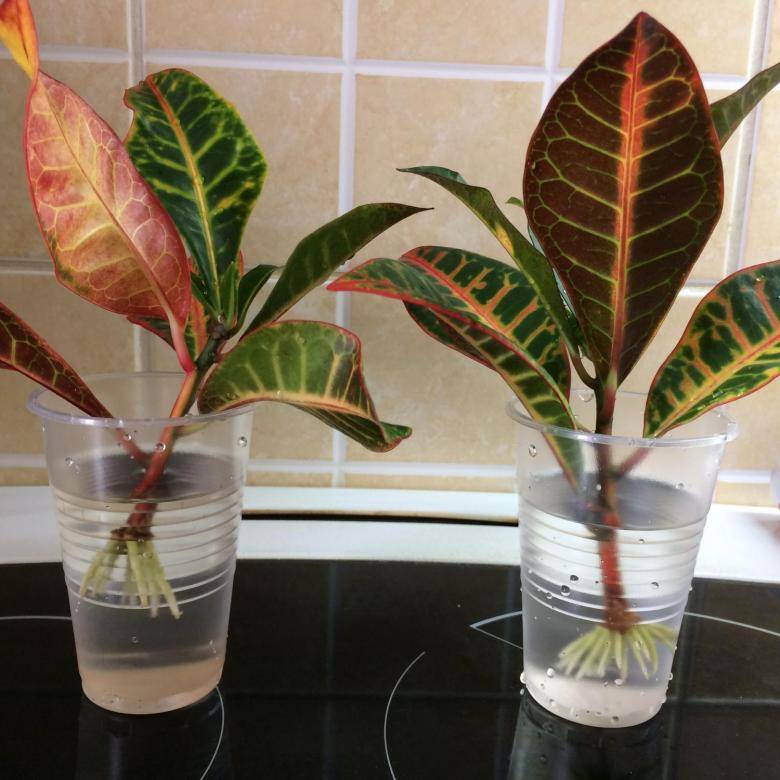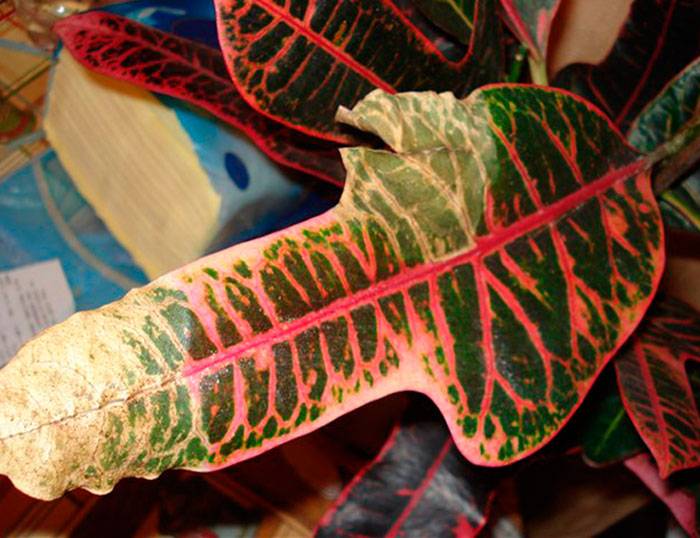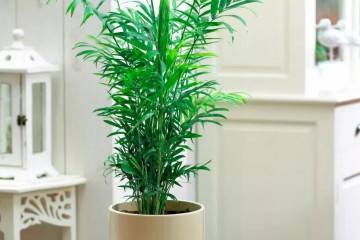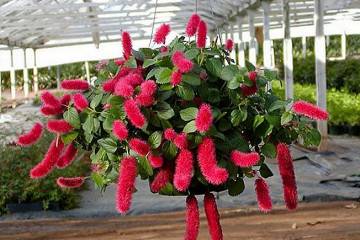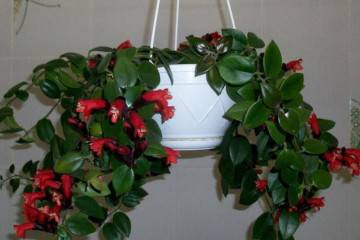Croton flower - home care
Content:
Croton belongs to decorative deciduous plants. His flowers are inconspicuous, but the leaf plates are so bright that they inevitably attract attention. The plant appeared relatively recently on the shelves of flower shops, but immediately won the hearts of lovers of home flora. Below is information on growing codiaum at home.
General information
Croton is a plant that belongs to the Euphorbia family. In nature, it reaches a size of 3-4 m. Of the many species, variegated codiaum is used for keeping indoors, on the basis of which breeders have bred numerous hybrids. Their height does not exceed 50-70 cm. The leaves of hybrid plants are different in shape and color.
Common varieties
At home, the following varieties of codiaum varigatum are grown, which are the most popular:
- Excellent. Its leaf plates follow the shape of oak leaves. Their upper part is painted yellow-green, the lower one is painted with a red-burgundy palette;
- Mrs. Aiston. The short leaf plates of the variety are painted first in a cream color, gradually changing color to pink. There are yellow spots all over the surface of the leaves;
- Peter. The bush reaches a height of 50 cm. Large oval leaves are painted yellow-green;
- Mummy. The peculiarity of the variety is in curling narrow leaves. The predominant palette of Mammi codiaum is orange-red;
- Zanzibar. This croton with its lanceolate leaves resembles dracaena. The leaf plates of a flower can be yellow, green, or purple;
- Mix. So usually in flower shops they call several copies of croton of the same variety, collected together.
In addition to these varieties, growers choose Gold King, Golden Star, Norma for keeping at home.
Healing properties
The plant contains acids: acetic, linoleic, oleic, crotonic. They help the body to cope with harmful microorganisms, have a beneficial effect on digestion. In addition, the substances that make up croton have a laxative, sedative, antioxidant effect.
History of appearance
The homeland of Croton is considered to be East India, Australia, the Pacific Islands, where it grew in the wild. Lovers of ornamental plants liked the flower so much that they decided to cultivate it. Bushes with spectacular leaves were brought to Europe, where they gained great popularity, and then spread throughout the world.
Care features
The pot for the codiaum is selected in such a way that the root system quickly braids it. As the bush grows, the container is increased by 1-2 cm annually. If the croton flower is properly cared for at home, the plant will delight its owner and his guests with a decorative look for a long time.
Temperature
The most favorable air temperature is 20-25 ° С. In winter, it should not fall below 17 ° C. In the spring, the flower can be taken out on the open balcony or terrace of the house. At the end of summer, he is brought back into the room so that he has time to get used to the room temperature before the heating turns on.
Lighting
Croton needs to be provided with a well-lit place, but without the sun's rays falling on the leaf plates. The flower will grow best on the west or east side.
Watering
The codiaum is watered abundantly after the topsoil has dried. After half an hour, the excess liquid is removed from the pallet. To prevent the formation of a crust, which prevents the "breathing" of the flower, the top layer of the soil is loosened the next day after watering.
Spraying
The leaf plates are periodically wiped from dust and sprayed with water from a spray bottle. In the summer, you can have a shower by covering the soil with plastic wrap. Water for spraying should be used warm, settled.
Humidity
If the air in the room is dry, croton leaves may begin to dry, then fall off. To increase the humidity, a container with water is placed next to the flower. In winter, you can put a wet towel over the radiators and moisten it as it dries.
Priming
The plant requires a light, fertile soil. You can prepare it yourself from the following components:
- leaf humus;
- garden land;
- peat;
- river sand.
The components are mixed, pieces of charcoal can be added to them, which will serve as a disinfectant. For planting croton in a flower shop, you can purchase a ready-made substrate.
Top dressing
In spring and summer, Croton flower is fertilized once every 2 weeks with mineral dressing, which is bred according to the instructions. In autumn and winter, it is enough to feed the bushes once a month. Some growers add used tea leaves and coffee grounds to increase the fertility and looseness of the soil.
Features of winter care
In the cold season, watering the codiaum is significantly reduced. The soil is only slightly moistened, not allowing it to dry out completely. Croton is fertilized once a month in winter. Some growers recommend not doing this at all, giving the flower a rest. Souling is not performed in the winter.
When and how it blooms
With good care, croton blooms can occur at any time of the year. But he produces small, inconspicuous flowers, so many growers get rid of them.
Pruning
The procedure is an obligatory part of the care. The purpose of pruning is to give the bush a decorative effect. To do this, a 10-15 cm long tip is cut off with a sharp knife, after which dormant buds begin to sprout from the sinuses, the bush gradually begins to branch. The most painless plants will undergo the procedure in the spring.
The top can be rooted by removing the poisonous sap from the cut and planting it in loose soil.
How croton reproduces
If you approach the procedure armed with knowledge, cultivation of a flower will not cause difficulties. At home, reproduction of codiaum can be done in several ways: by seeds, cuttings, air layers.
Germinating seeds
You need to plant freshly harvested seeds. The procedure is performed as follows:
- The seeds are left in warm water to swell.
- Then they are planted in a light substrate to a depth of no more than 1 cm.
- Watered with water, covered with soil.
- Cover the container with plastic wrap.
When shoots appear, the shelter is removed. The bushes are routinely cared for; as they grow, they need to be planted in larger containers.
Rooting cuttings
Most often, apical cuttings are used for reproduction. The procedure is performed as follows:
- Cut off a stalk 10-15 cm long.
- The slice is washed with water.
- The lower leaves are removed, the upper ones are slightly pruned.
- The stalk is placed in a glass of water.
- When the roots appear, they are planted in a container with fertile soil.
Air layering
To propagate croton with air layers, you need to cut off the bark around the shoot, exposing 1-1.2 cm. The place of the cut is dusted with a growth enhancer, covered with wet sphagnum moss. Then the shoot is wrapped with a film, which is fixed with a thin wire. Roots will soon appear in the place where the bark is cut. When this happens, the cutting is cut and planted in a pot.
Transfer
Immediately after purchase, the codiaum flower is installed for two weeks in a shaded place. When the flower gets used to the new conditions of detention, it needs to be transplanted. To do this, choose a pot whose diameter is 1-2 cm larger than the previous one. The plant is transplanted by the transshipment method, adding fresh substrate to the space between the container and the earthen clod.
Possible growing problems and diseases
The beauty of a flower lies in its decorative leaves. If the bushes are improperly looked after, the leaf plates can begin to dry, fall off, and change color.
Drops buds and leaves
Perhaps croton lacks moisture. The plant urgently needs to be watered, wiped with a damp cloth. Another reason for dropping buds and leaves is that the plant is cold, and the roots have ceased to deliver moisture to the stems and leaves. In this case, the flower must be placed in a room with a temperature of 17 ° C.
Leaves turn pale
Leaf plates can be discolored when exposed to direct sunlight. In addition, a lack of light may be the reason for the whitening of the leaves. To remedy the situation, the croton must be transferred to a windowsill, well illuminated by the sun, but shaded at noon from the glare of the sun.
The tips of the leaves dry
The reason for this state of the flower is that the air in the room is too dry. Croton should be placed away from the radiator, place a container of water next to the flower. In summer, the bushes are sprayed with warm water, periodically they are given a shower.
The lower leaves fall
If leaf plates fall off in an adult plant, then there is no cause for concern, since this is a natural process. The falling of the lower leaves in young bushes can occur due to their location in a draft, sudden changes in air temperature, lack or excess of water.
Pests
Pests can appear on a plant with a weakened immune system. A sign that croton has chosen a spider mite is the presence of a cobweb on the leaves. In addition, they harm, reduce the decorative effect of the flower, scale insects and mealybugs. To get rid of pests, you need to wipe the leaves with soapy water. If there are many harmful insects, some kind of insecticide is used.
Diseases
Croton can infect anthracnose, which occurs when using cold water. To get rid of the disease, the flower is treated with any fungicide.
Another common disease is root rot, in which the leaves dry out and then fall off. The reasons are low soil acidity, excessive watering. Antifungal drugs are used to combat the disease.
Signs and superstitions
Indoor decorative croton flower has powerful energy. It helps to establish balance in the house, gives confidence to indecisive people.It is not recommended to buy a flower for lovers to talk a lot and loudly, restless and hysterical personalities. As codiaum increases energy, such people will become even more restless and annoying.
Croton with its spectacular leaves is able to decorate even the most modest interior. Like any beautiful plant, it requires attention from the florist. Receiving the necessary care, at home, the codiaum will delight others with its decorative appearance for many years.



